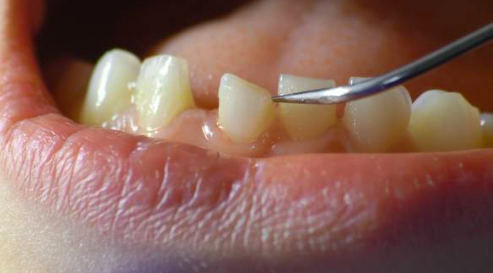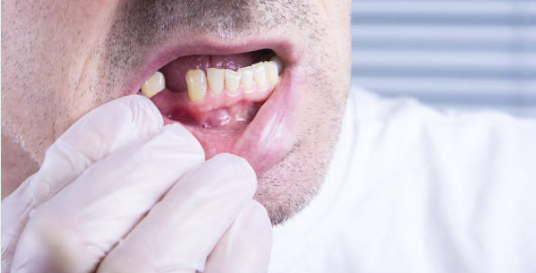Looseness of a tooth or tooth mobility can vary from minimal looseness to severe looseness. The movement of the loose tooth in its socket is observed and it must be noted that severely loose teeth demonstrate movement in a horizontal (side-to-side) and vertical (away from the socket and/or deeper into the socket) direction.
If you experience looseness of any tooth, it is in your best interest to get yourself checked by your dentist. Together with a detailed account of your dental history and any history surrounding your loose tooth, the dentist can point out the cause of the looseness and then provide a comprehensive dental treatment that best suits your case.
Why is my tooth loose?
There are two types of tooth looseness: 1) physiologic and 2) pathologic. Physiologic tooth looseness shows in the very, very slight tipping of teeth during chewing and is not associated with any oral or dental disease. Pathologic looseness of teeth occurs in conjunction with trauma or injury to the teeth, gums, the bone underneath, and other associated structures in the mouth.
There are different causes of a loose tooth, and most of them indicate that you have a dental problem that needs to be addressed as soon as possible.
You have gum disease
Poor oral hygiene leads to gum disease. Gingivitis is the inflammation of the gums due to the build-up of bad bacteria on your teeth and around your gums. Gingivitis is reversible, meaning, you can go back to having a healthy mouth without gingivitis.
However, if you let your gingivitis get worse, this can lead to periodontitis and a common feature of this is having a loose tooth. This is because the bacteria travel deeper into your gum tissues, into areas that cannot be reached by your toothbrush alone. This bacterial invasion can lead to bone loss which significantly lessens the support around your tooth. In some cases, the tooth looseness becomes so bad that there is no other choice but to remove the tooth.
You experienced trauma on your dental tissues
You can have a loose tooth or even have multiple teeth loose after experiencing an accident such as falling face-first on the floor or having a hard object hit you on your face. The bleeding from such incidents must be addressed quickly, and your dentist will examine the extent of the injury on your tooth since some accidents could cause the underlying bone to be fractured.
Another cause of trauma on your teeth would be the force you exert upon them when biting or clenching. This places too much force on the supporting tissues of your teeth which would over time lead to looseness of your teeth.
In some cases, there are patients who have restorations that are “too high”, in the sense that the biting surface of the restored tooth contacts the opposing tooth earlier compared to other teeth. This causes pain and must be managed by your dentist accordingly. If not, the opposing tooth will experience looseness in the long run.
You have an ongoing tooth infection
Your tooth has dental caries and it has very big and dental cavity. A really deep cavity could reach into the pulp which is the soft, jelly-like mass of tissue at the innermost part of your tooth. It has nerves and blood vessels and is responsible for your teeth’s defense mechanism against dental decay.
However, too much decay that has encroached on the pulp can become irreversible, and if not treated early on, the infection caused by the decay can travel to the surrounding tissue that supports your teeth. Again, any injury to the supporting tissues of your tooth can lead to looseness.
You underwent periodontal therapy recently
For people with periodontitis, a comprehensive treatment called periodontal therapy is done so that they may have a healthy oral cavity. This treatment involves the use of surgical instruments to clean the deeper parts of the gums.
If you have recently undergone this type of treatment, your dentist should have explained to you that you may experience some transient looseness of your teeth. This looseness will go away 2-3 weeks after your treatment as long as the procedure was done correctly.
You have osteoporosis
Osteoporosis is a skeletal disease wherein bone mass and the density of bone mineral decreases, resulting in weaker bone strength and a higher risk of fractures. The bone underneath the gums can also be affected if you have osteoporosis, which is why you can have loose teeth along with the disease.
The risk of developing osteoporosis is greater in women in general, especially those who have had menopause.
You are undergoing orthodontic treatment
For patients who just had their braces adjusted during ongoing orthodontic treatment, transient tooth looseness is normal since the teeth are also adjusting to their position.
However, a common problem among patients with orthodontic braces is gingivitis. Difficulty in cleaning their teeth leads to the accumulation of bacteria and food debris on their teeth and gums. If not managed well, this could lead to periodontitis wherein loosening of teeth becomes apparent, and orthodontic treatment will need to be stopped so that periodontitis can be addressed and treated.
Can a loose tooth tighten back up?
Depending on the cause of the looseness and the treatment indicated for it, it may or may not tighten back up.
If you have gum disease and you decided to practice better oral hygiene (including visits to the dentist twice a year), then, yes your loose tooth or teeth will tighten back up. This is also true for patients who have undergone periodontal therapy, as long as they continue to take better care of their oral cavity.
If the reason for your loose tooth is injury, it most likely won’t tighten back up since removal of the tooth will be done and you get to decide with your dentist whether you’ll get a bridge, a removable denture, or an implant.
If you are experiencing loose teeth and you have osteoporosis, you might need to undergo some surgical procedures such as regenerative bone and gum grafting which aims to restore the supporting tissues around your teeth. This can help strengthen the support on your teeth thereby tightening the tooth in place.
How do you treat a loose tooth?
The treatment for a loose tooth depends on the cause, which is why history taking is a crucial part of your dental visit. This helps your dentist point out the origin of the looseness before proceeding with your treatment.
A loose tooth caused by gum disease will benefit from more frequent oral prophylaxis which means that you will have to visit your dentist more than twice a year. Severe gum disease or periodontitis indicates that the patient undergoes periodontal therapy which involves surgical procedures to clean even further in the gums.
For patients undergoing periodontal therapy, splinting can be done to stabilize loose teeth during the treatment process. This helps prevent the loose teeth from drifting while therapy is ongoing since the therapy can go on for weeks until health is achieved, and the patient can demonstrate and maintain effective oral hygiene measures.
Flap surgery may also be done for patients with loose teeth due to periodontitis. This procedure involves making incisions on the gums, pulling the gum tissue to clean the underlying surface, then re-attaching the gum tissue back in place.
If you experience a loose tooth because its opposing tooth is too “high” or has a restoration that is too high, immediately inform your dentist so that your bite can be adjusted. This adjustment can be done by grinding or removing a small amount of enamel on the high tooth until a harmonious bite is achieved.
Is it OK to leave a loose tooth?
It is undesirable to ignore a loose tooth. This looseness can worsen and progress to a point wherein your tooth can no longer be saved and only tooth extraction can be done. This leaves you with fewer teeth, a sloppier smile, and even problems with digestion if you only have a few teeth left behind. This would also cause you to spend more money on treatments that aim to restore the function of your lost teeth, such as dentures or implants.
In conclusion
Consistent practice of oral hygiene measures is highly beneficial if you want to avoid having loose teeth. Keep in mind that you must brush your teeth with a soft-bristled toothbrush at least twice a day and each brushing session must last for at least two minutes. Floss your teeth daily since your toothbrush cannot reach into the spaces between your teeth and you might have some gunk left in there. Visit your dentist twice a year for your dental check-up and professional cleaning. Be careful as well in your daily activities so as to avoid accidents that may cause you to fall or slip.
Sources:
Bernal, G., Carvajal, J. C., & Muñoz-Viveros, C. A. (2002). Clinical management of mobile teeth. J contemp dent pract, 4(3), 10-22.
Lang, N. P., Berglundh, T., Giannobile, W. V., & Sanz, M. (Eds.). (2021). Lindhe’s clinical periodontology and implant dentistry. John Wiley & Sons.
National Institute of Arthritis and Musculoskeletal and Skin Diseases. on Osteoporosis, N. C. D. P., & Prevention, D. (2001). Osteoporosis prevention, diagnosis, and therapy. JAMA, 285(6), 785-795.
Sahu, P. (2020). Teeth Mobility Cause and Management of Mobile Teeth in Dental Clinic. Indian Journal of Forensic Medicine & Toxicology, 14(4).
Sidiropoulou-Chatzigiannis, S., Kourtidou, M., & Tsalikis, L. (2007). The effect of osteoporosis on periodontal status, alveolar bone and orthodontic tooth movement. A literature review. Journal of the International Academy of Periodontology, 9(3), 77-84.





